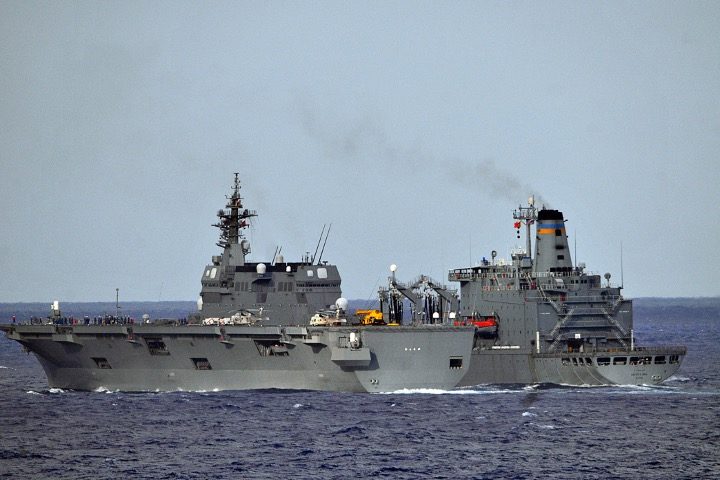
On Saturday, November 11, Japan led a yearly multinational naval exercise that included the Philippines as an observer for the first time, as Philippine coast guard vessels have been increasingly harassed by China in the contested South China Sea.
Territorial conflicts in the South China Sea entailing China, the Philippines, Vietnam, Malaysia, Taiwan, and Brunei have long been deemed as a fragile fault line in the Sino-U.S. superpower rivalry.
The AnnualEx exercises that began off Japan’s coast also included the United States, Australia, and Canada, and sought to explore ways the navies can cooperate and display their presence and commitment to defend a “free and open” Indo-Pacific, which the allies claim has been obstructed by China’s military pugilism that encapsulates widespread territorial claims.
Journalists, including those from The Associated Press (AP), flew on a V-22 Osprey aircraft to the USS Carl Vinson aircraft carrier to witness takeoffs and landings of F-35C “Lightning” stealth fighters, as well as F/A-18 Super Hornet jets and E/A-18 Growlers, on Saturday.
The weekend’s exercise came amid the latest confrontation between the Philippines and China in the South China Sea on November 10, compounding bilateral territorial grievances that risk exploding into a more serious military conflict.
The Philippines lambasted a Chinese coast guard ship and accompanying vessels for dangerous maneuvers and blasting a Philippine supply ship with a water cannon, while China justified its move.
“The Philippines is an extremely important country for Japan, and we hope to cooperate with the Philippine navy at every opportunity in the future,” Japan Maritime Self-Defense Force Commander-in-Chief Akira Saito posited, before elaborating that the exercises were not aimed at any particular country and that the Philippines’ participation was decided before its latest skirmish with China.
About 30 navy ships and 40 warplanes from the four countries, as well as Philippine navy personnel, were also involved in the joint exercises tackling new threats such as cyber, space, and information warfare, according to Saito.
U.S. Seventh Fleet Commander Vice Adm. Karl Thomas said that most countries in the Asia-Pacific region shared ideas about maritime security and prosperity, and “the more our navies work together, the more multilateral our exercises are, the greater the security for this region.”
Thomas added the U.S. Navy has deployed two aircraft carriers, the USS Carl Vinson and the USS Ronald Reagan, in the Pacific, notwithstanding “unfortunate situations happening in other parts of the world.”
Japan and the United States have ramped up defense collaboration, expanding their scope to include Australia and the Philippines. The allies share concern about China’s growing assertiveness and tensions over self-ruled Taiwan, which China claims as its own to be united by force if necessary.
Bilateral defense ties between the U.S. and the Philippines are bound by the 1951 Mutual Defense Treaty, the 1999 Visiting Forces Agreement, and the 2014 Enhanced Defense Cooperation Agreement.
The 2014 agreement permits the U.S. military to dispatch troops and weapons to five military bases in the Philippines, and on February 2 this year, the two countries inked an agreement permitting the U.S. military access to four additional military bases in the Philippines, including those in the northern part of the country close to Taiwan and the Spratly Islands.
The Philippines’ strategic location has become vital for the U.S. for military operations and strategies to deal with the expansionism of communist Beijing.
Japan has not been left out of Philippine defense calculations either. In early November, Japanese Prime Minister Fumio Kishida and Philippine President Ferdinand Marcos Jr. agreed to begin talks on a major security pact that would allow their troops to enter each other’s territory for joint military drills. Additionally, Japan promised to supply surveillance radars to the Philippine navy under a new military grant.
In a November 4 speech to the Congress of the Philippines in Manila, Kishida urged Japan and the Philippines to enhance bilateral cooperation to preserve a global order based on the rule of law amid China’s ongoing maritime expansion.
“In the South China Sea, trilateral cooperation to protect the freedom of the seas is underway,” the Japanese prime minister said.
Kishida maintained that the international community was at a turning point in its history, and the rules-based international order was facing grave challenges. He added that Japan was open to working with the Philippines to protect freedom and the rule of law, highlighting the importance of working with other allies such as the United States.
During the meeting, Marcos articulated hopes that the Philippines and Japan would also expand bilateral collaboration in fields such as economic development and security. The Philippine leader also mentioned that Washington, Japan, and the Philippines had established a framework for consultation among senior security officials in June this year.
During a subsequent press conference, he said Kishida’s visit to the Philippines signified a new milestone in the Japanese-Philippine partnership.
Due to the expansion of the Chinese Communist Party’s (CCP) control in the region, both leaders also voiced concerns about volatile circumstances in the East and South China Seas, concurring that any efforts to alter the status quo by force would be unacceptable.
Both the Philippines and China claim sovereignty over the Mischief Reef in the Spratly Islands. This year, the China Coast Guard increased its faceoffs with Philippine vessels in the area, with a China Coast Guard vessel colliding with a Philippines patrol ship on October 22.
In 2016, the Permanent Court of Arbitration in The Hague ruled that the Mischief Reef was within the exclusive economic zone of the Philippines. Nonetheless, the CCP established a military base on the island, including military radars, a runway for fighter jets, and a missile depot.
Owing to Chinese military presence in the area, the Mischief Reef area has been classified as a dangerous zone, with foreign fishing vessels compelled to steer clear of the waters where they had been fishing for generations.
On its end, Japan also has territorial disputes with China. China claims that the Senkaku Islands are Chinese territory, while Japan insists that the islands have been incorporated into Japanese territory since 1895 and have continued to be a part of Japan under international law since the Second World War. In 1992, the CCP enacted a law insisting that those islands were Chinese territory, and China has dispatched ships into the waters and has been engaged in many stand-offs with Japan since 2008.



